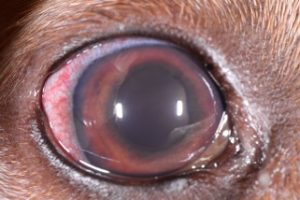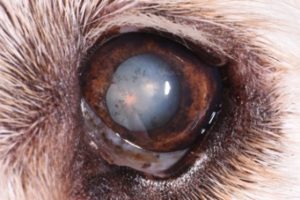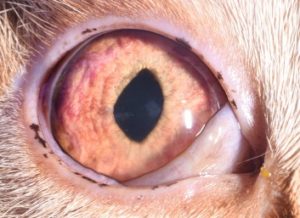Canine uveitis
Inflammation inside the eye is called uveitis. Typically, this inflammation occurs due to leaky blood vessels in the iris (the colored portion of the eye). Signs of uveitis can be subtle and include squinting, rubbing at the eyes, and mild discharge; or they can be severe with redness, hazy, or cloudy appearance to the eyes, and decreased vision. Some patients have mild uveitis with normal vision and mild discomfort while other have severe and painful uveitis.
 A diagnosis of uveitis is sometimes due to underlying systemic disease, therefore a comprehensive diagnostic evaluation is recommended. In Colorado, some of the most common systemic diseases that cause uveitis in dogs include tick-borne disease, some fungal diseases, and cancer. It is recommended that every patient diagnosed with uveitis have full bloodwork (CBC and chemistry), urinalysis, and tick-borne disease testing. Additional diagnostics such as chest X-rays, abdominal ultrasound, or other infectious disease testing may be recommended.
A diagnosis of uveitis is sometimes due to underlying systemic disease, therefore a comprehensive diagnostic evaluation is recommended. In Colorado, some of the most common systemic diseases that cause uveitis in dogs include tick-borne disease, some fungal diseases, and cancer. It is recommended that every patient diagnosed with uveitis have full bloodwork (CBC and chemistry), urinalysis, and tick-borne disease testing. Additional diagnostics such as chest X-rays, abdominal ultrasound, or other infectious disease testing may be recommended.
If no underlying cause is uncovered as a part of the comprehensive diagnostic evaluation, your dog’s uveitis may be considered immune-mediated or idiopathic (no obvious underlying cause).
Aggressive treatment is required initially to prevent glaucoma, scarring of the uveal tissues, and potentially blindness. Treatment for uveitis includes topical and systemic anti-inflammatory medication in addition to treatment of any underlying disease process. Atropine is also recommended (provided intraocular pressures are normal) to decrease pain and dilate the pupil. Frequent rechecks are recommended until the inflammation is under control. Some patients have transient uveitis that lasts weeks, while other require lifelong treatment. Diligent uveitis control is necessary to prevent ocular pain and vision loss.
Golden retriever uveitis
Golden retriever uveitis, or pigmentary uveitis is an eye condition found in golden retrievers, and with an unknown cause. Onset typically occurs in middle-aged dogs, and is characterized by low levels of inflammation inside of the eye. Signs noticed by owners often include squinting, increased tearing or discharge, mild redness, photophobia (light sensitivity), and cloudiness of the eye or eyes. There is a presumed inherited component, and the inflammation does not appear to be associated with any systemic disease or infection.
 Golden retriever uveitis is typically a bilateral progressive disease, but only one eye can be affected initially. Early in the disease process, inflammation in the eye is usually very subtle and may not be evident by casual observation. On eye examination, dogs will often have redness of the eye, inflammation inside of the eye (uveitis), and pigment dispersed across the inner tissues of the eye. Some dogs also develop cataracts secondary to the inflammation. As the amount of inflammation and pigment increases, it can clog the normal drainage pathway for the fluid inside of the eye, and cause glaucoma (elevated pressure inside of the eye). If the glaucoma is not treated, it can lead to blindness and permanent discomfort.
Golden retriever uveitis is typically a bilateral progressive disease, but only one eye can be affected initially. Early in the disease process, inflammation in the eye is usually very subtle and may not be evident by casual observation. On eye examination, dogs will often have redness of the eye, inflammation inside of the eye (uveitis), and pigment dispersed across the inner tissues of the eye. Some dogs also develop cataracts secondary to the inflammation. As the amount of inflammation and pigment increases, it can clog the normal drainage pathway for the fluid inside of the eye, and cause glaucoma (elevated pressure inside of the eye). If the glaucoma is not treated, it can lead to blindness and permanent discomfort.
The cause of this disease is unknown, which can be very frustrating for owners. Golden retriever uveitis is a chronic concern that requires long-term treatment. Treatment for golden retriever uveitis is initially aimed at reducing inflammation in the eye and preventing or delaying the onset of glaucoma. However, most dogs eventually develop complications from the chronic inflammation, and end up becoming blind in one or both eyes. At that time, the primary goal becomes ensuring comfort of the patient and removal of the eye is often the best choice. The initial treatment protocol will vary for each individual patient, but may include an anti-inflammatory eye drop, an oral anti-inflammatory, an oral immunosuppressant and/or medication to delay the onset of or treat glaucoma. Routine blood work may be advised if systemic medications are being used in order to monitor for any side effects.
Feline uveitis
Uveitis is a condition is which inflammation occurs within the eye. Typically, this inflammation occurs due to leaky blood vessels in the iris (the colored portion of the eye). Signs of uveitis can be subtle and include squinting, rubbing at the eyes, and mild discharge; or they can be severe with redness, hazy or cloudy appearance to the eyes, and decreased vision.
 A diagnosis of uveitis raises concern for underlying systemic disease, therefore a comprehensive diagnostic evaluation is recommended. In Colorado, some of the most common systemic diseases that cause uveitis in cats include feline infectious peritonitis, feline immunodeficiency virus, feline leukemia virus, other infectious diseases (Bartonella), and cancer (particularly lymphoma). It is recommended that every patient diagnosed with uveitis have full bloodwork (CBC and chemistry), urinalysis, and infectious disease testing. Additional diagnostics such as chest X-rays or abdominal ultrasound may be recommended.
A diagnosis of uveitis raises concern for underlying systemic disease, therefore a comprehensive diagnostic evaluation is recommended. In Colorado, some of the most common systemic diseases that cause uveitis in cats include feline infectious peritonitis, feline immunodeficiency virus, feline leukemia virus, other infectious diseases (Bartonella), and cancer (particularly lymphoma). It is recommended that every patient diagnosed with uveitis have full bloodwork (CBC and chemistry), urinalysis, and infectious disease testing. Additional diagnostics such as chest X-rays or abdominal ultrasound may be recommended.
If no underlying cause is uncovered as a part of the comprehensive diagnostic evaluation, your cat’s uveitis may be considered immune-mediated or idiopathic (no obvious underlying cause).
Aggressive treatment is required initially to prevent glaucoma, scarring of the uveal tissues, and potentially blindness. Treatment for uveitis includes topical and systemic anti-inflammatory medication in addition to treatment of any underlying disease process. Atropine is also recommended (provided intraocular pressures are normal) to decrease pain and dilate the pupil. Frequent rechecks are recommended until the inflammation is under control.
Equine recurrent uveitis
Equine recurrent uveitis, or moon blindness, is likely the most common cause of blindness in horses. It is estimated to affect anywhere from 2-25% of horses in the United States. The disease is characterized by recurrent episodes of intraocular inflammation, followed by periods of remission. The disease process is immune-mediated, but usually begins with an initial inflammatory event, and progresses with subsequent breakdown of the protective layers of the eye. This disruption results in an exacerbation of inflammation. The exact cause of the disease is not exactly known, however bacterial (leptospirosis), viral, and parasitic infections, as well as noninfectious etiologies have been associated with the syndrome and their involvement of the initial inflammatory event is suspected. Factors such as genetics may also play a role in the development of this disease. The disease generally involves all aspect of the equine eye and can progress to scarring of the cornea, cataracts, adhesions of the iris (synechia), glaucoma, and chronic pain. Without appropriate management and adequate control, the disease may progress to blindness.
Treatment options generally begin with a variety of topical and systemic anti-inflammatories. It is imperative to treat a patient as soon as clinical signs are noticed, because untreated inflammation can lead to permanent changes and scarring within the eye. If patients respond well to topical therapy, slow-release cyclosporine implants can be surgically placed behind the globe. This implant will increase the time between recurrences, shorten the duration of active episodes of uveitis, and hopefully delay the onset of blindness. These implants are placed under general anesthesia, and do no cure equine recurrent uveitis, but often help manage it. Implants typically last between two and five years, and while topical medications are often decreased, most patients stay on some level of topical therapy. This therapy can minimize future inflammation and damage to the eye; however, it will not fix any scarring or cataract that has already occurred.